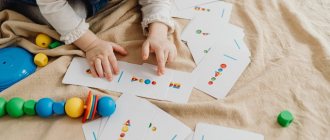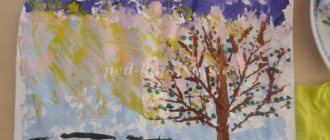Open lesson on communication in the middle group on the topic: “Pets”
Open lesson on communication in the middle group on the topic: “Pets”
Goals and objectives:
Educational:
1. Learn to use the instrumental case of nouns, practice agreeing words by case.
2.To consolidate and clarify children’s knowledge about domestic animals and their cubs;
3. Exercise children to answer the teacher’s questions with a complete answer.
4. Compiling a descriptive story of the animal according to the diagram.
Developmental:
1.Develop auditory and visual perception, fine motor skills;
2.Improve thought processes;
Educational:
1. Cultivate a love for pets;
2. Develop the ability to listen carefully, develop the cognitive process;
3.Develop communication skills.
Equipment: easel, pictures of domestic and wild animals, toys of wild and domestic animals, model of the “village” and “forest”, rubber massage balls, sound panel “pets”.
Progress of the lesson:
Children enter the group and greet the guests.
Organizing time.
Educator: I invite you on a journey into the animal world. This morning a white-sided magpie flew into my window and brought a letter from my grandparents on its tail. Let's read it! He takes the letter out of the envelope and reads: Hello, dear boys and girls. We had a problem - all the animals from our yard fled. Please help me find them. And to find our animals, you need to solve riddles.
D/game “Riddles”
I serve my master -
The master's house is a watchman.
I growl and bark loudly
And I drive away strangers.
Educator:
The very first animal that man made his friend was a dog. Let's remember what a dog eats?
Soft paws, and scratches in the paws.
The cat is a flexible, graceful animal. She loves her owners, her home, she likes to bask in the warmth and comfort, bask in the sun or lie down in a soft chair. What does a cat eat? (children's answers)
She says “mu-mu!”
At night he sleeps in his stable,
During the day he goes to the pasture.
He gives us milk.
The cow's body is large, with rounded, swollen sides. The long tail resembles a whisk. The cow has a large head with upturned horns, erect ears with which she can hear well, and large eyes. The cow eats lush green grass and loves hay.
“M-e-e!” - Who’s calling the guys? Who's shaking his beard?
Who has twisted horns and berry-like eyes?
This is approaching the children along the path... (goat)
A goat, like a cow, eats grass and hay. A goat is a small animal, its body is covered with thick hair. The goat's legs are tall and slender, and its tail is short. The goat has sharp horns on its head.
I have a snout, instead of a tail there is a hook,
I love to lie in a puddle and grunt: “Oink! Oink!”
The pig has a large head ending in a round snout, large erect ears and small eyes. The pig sees poorly, but its hearing and sense of smell are excellent. The pig has a thick, round body, a ringed tail and slender legs with hooves. The pig is an omnivore.
Working on an easel
Educator:
Let's name these animals again. (Children take turns listing the animals posted on the board)
Educator:
What can you call these animals in one word? (Pets)
Educator:
Why are they called that?
Children:
Because pets are cared for by humans, housing for pets is built by humans, and pets are useful to humans.
Educator: While you and I were guessing the pets, all the animals got mixed up. Help me put things in order.
Modeling
(wild and domestic animals are located on the tables, children sort out the animals, who lives where).
Educator:
What is this?
Children:
Village house.
Educator:
And what's that ?
Children: Forest.
Educator:
Distribute the animals according to their habitats. Well done! Everyone completed the task!
Animals can communicate with each other just like people, but they all speak differently. Let's remember who says what... Now I suggest playing the game “Find your mother by voice”
D/game “Find your mother by voice” (Use of sound panel)
D/exercise “Find your mother” children find their baby by sound.
- Who's with the dog? - a puppy, and there are a lot of ... (puppies)
-Who is the cow? – a calf, and there are a lot of...(calves)
- Who is with the horse? - a foal, and there are many...(foals)
- Who is the cat? - kitten, and there are many... (kittens)
- Who's with the pig? - a piglet, and there are a lot of... (piglets)
-Who is the goat? - a kid, and there are a lot of ... (kids)
Educator: Well done guys! You found each cub its mother. Now let's take a little rest. Everyone come to me and take the ball.
Physical education minute
Pets
One two three four five,
What should we call animals? (we bend the fingers on the left hand one by one)
The closest, the most faithful -
Everyone probably knows them (clap our hands).
Horse, cow, dog and cat (use the index finger of the left hand to bend the fingers on the right hand).
What should we call them?
Think a little (we spread our arms to the sides, as if asking others).
They live together in the house with the owner (we depict the roof of the house above our heads with our hands),
So, everyone calls them home.
D/game
“Which picture is extra”
Children should see a wild animal among domestic animals.
Descriptive story according to the scheme
about any pet.
Lesson summary:
Guys, our journey into the animal world has come to an end. Who did we talk about today? What did you enjoy doing today? What new have you learned? Pets need to be protected and cared for.
Communication games in the middle group
Baldanova Elizaveta
Communication games in the middle group
Communication games in the middle group.
Crocodile
Goal: development of dexterity, observation, removal of fears.
Age: 4-5 years.
Number of players: 8-10 people.
Game description : children choose a “crocodile”
.
The chosen one stretches his arms forward, one above the other - this is the mouth of the crocodile - and walks around the room (the platform, singing songs, dancing, jumping. Meanwhile, the children put their hands in the mouth. At some point, the “crocodile”
closes its mouth. Who did not have time to pull out his hand , becomes
a "crocodile"
.
Comment : in the role of a “crocodile”
As many children as possible should attend in order to experience the change in role sensations.
Cooks
Goal: development of communication skills , sense of belonging to a group .
Age: over 4 years old.
Number of players: group of children .
Description of the game : all children stand in a circle - this is a “pan”
or
"bowl"
.
Then the children agree on what they will “cook”
- soup, compote, salad, etc. Everyone comes up with what it will be: potatoes, meat, carrots or something else.
The presenter is an adult, he shouts out the names of the ingredients. The person named jumps into the circle, the next component takes his hand, etc. When all the children are back in the same circle, the game ends, you can start preparing a new “dish”
.
Comment : it’s good if the presenter performs some actions with the “products”
: cut, crumble, salt, water, etc. You can simulate boiling and stirring.
This game helps relieve muscle tension and stiffness through a light imitation massage.
Game "Shadow"
.
Goal: developing attention to the feelings of others.
Progress: children are divided into pairs: one is a person, the other is a shadow. The man makes movements, the shadow repeats.
Newspaper
Goal: development of communication skills , overcoming tactile barriers.
Age: 4-5 years.
Number of players: four, or a multiple of four.
Necessary equipment: newspaper.
Description of the game : an unfolded newspaper is placed on the floor, on which four children stand. Then the newspaper is folded in half, all children must stand on it again. The newspaper is folded until one of the participants can stand on the newspaper. During the game, children must understand that to win they need to hug - then the distance between them will be reduced as much as possible.
Comment : this game helps children overcome shyness before physical contact, removes the “muscular armor”
, makes them more open. This is especially important for withdrawn and timid children, as well as for children who have suffered some kind of trauma.
The game will be more interesting if children act on command. In other words, they must stand on the newspaper after a certain signal, and between them they can move freely around the room. After the children stand on the newspaper, the adult should record their location and give the children the opportunity to feel the support of their neighbor.
Palm to palm
Goal: development of communication skills , gaining experience of interaction in pairs, overcoming the fear of tactile contact.
Age: any.
Number of players: 2 or more people.
Necessary equipment: table, chairs, etc.
Description of the game : children stand in pairs, pressing their right palm to their left palm and their left palm to their friend’s right palm. Connected in this way, they must move around the room, avoiding various obstacles: a table, chairs, a bed, a mountain (in the form of a pile of pillows, a river (in the form of a laid out towel or a children's railway)
etc.
Development of emotions and feelings in preschool children
Comment : in this game a couple can be an adult and a child. You can complicate the game if you give the task to move by jumping, running, squatting, etc. Players need to be reminded that they cannot unclench their palms.
The game will be useful for children who have difficulty communicating.





